Simple Italian Tomato Sauce (That Any Nonna will Approve)
Views: 182
This no-garlic, no-oil, no-acid-added Italian tomato sauce from scratch is stripped down to its basics and tomato-forward. We put fresh tomatoes through the food mill for smoothness, then we simmered them with salt and basil until they’re rich, fragrant, and canning-ready. Processed long and slow, it’s the purest version of homemade tomato sauce from fresh tomatoes you can jar – just how your imaginary Nonna probably did it (before she judged your jar labels).
Like most of us, you’ve probably fallen for those store-bought jars claiming to be “slow-cooked,” “hand-stirred,” and “Tuscan-nonna-approved.” So now you’re here, side-eyeing this recipe, thinking: Is this really worth it?
The simple answer is – YES! This Italian tomato sauce is absolutely worth it! While it won’t make your pizza taste like DiGiorno, it’ll make it taste like it came from a tiny village where Nonna still glares at anyone who touches her tomato sauce too early.
Feel free to skip straight to the recipe, or hang out a bit for some handy tips, ingredient recommendations, and tricks to make this sauce truly exceptional. Promise, no grandma stories here!
Be warned, canning tomato sauce is hot, messy, and slow. You’ll sweat and you’ll mutter things. You’ll swear you’re never doing this again. But then, in the dead of winter, or in the heat of summer when you crave a real Italian pizza, you’ll crack open a jar—and suddenly, it will all make sense.
Tomato Acidity: It’s Complicated
Did you know? Not all tomatoes qualify as low- acid. In fact, the further your tomato is to perfect ripeness, the more acidic it probably is.
Something like this:
- Early season or greenhouse tomatoes → higher acidity
- Slightly under-ripe tomatoes → higher acidity
- Peak August, sun-ripened, juicy field tomatoes → lower acidity
Simply put, the tomatoes you lovingly let ripen to perfection are likely on the low end of the acidity scale. Nature’s little irony!
So why should you care? Because if you’re banking on acid to make your tomato sauce canning recipe safe, you’re playing guessing games.
Our method avoids all that. No guesses. Just long cooking times and proper technique.
Let’s Talk USDA (and Why We’re Even Having This Conversation)
If you’re North American and if you’ve been canning for more than 30 seconds, you know the USDA is the go-to name that comes up in any canning-related argument.
For one camp of the canners, the USDA is gospel. For the other, the “USDA-approved” gets tossed around like a foul curse.
So, here’s the thing, according to USDA guidelines, you must add vinegar or citric acid to tomatoes before water bath or steam canning. As per USDA, you must do so to destroy the spores, live bacteria and toxins that cause botulism. And, here’s the elephant in the kitchen: our tomato sauce recipe does not include acidification. It is a problem? Read on and decide for yourself.
For starters, what if we told you the USDA also says that boiling food vigorously for 10 minutes (longer at higher altitudes) will destroy botulinum bacteria and toxin?* That’s right. The spores may survive, but the toxin, which is what actually makes you sick, gets knocked out by a good boil. *Source: UC ANR – UC Master Food Preserver Program of Orange County – Botulism.
That’s how Nonna did it. She didn’t acidify – she boiled her Italian tomato sauce down to its deepest, richest essence. As the sauce reduced, the sugar concentration in the tomatoes increased, creating a less friendly home for any of the sneaky botulism spores that may have stayed behind. And that’s what we’re doing too.
Full disclaimer: This is NOT USDA-approved. If you want to follow USDA guidelines, pressure can your tomato sauce or acidify it. If you choose to can as described in our recipe, we recommend that you heat the tomato sauce until it bubbles before eating it.
Tips for success
![]() Use a food mill—or a box grater.
Use a food mill—or a box grater.
We don’t always love food mills, but this is that time when they’re super helpful. Food mill separates the seeds and skins from the tomato pulp quickly and easily.
If you don’t have one, a coarse box grater works too. It’s a lot messier, but it still gets the job done.
![]() Take out the seeds and juice first.
Take out the seeds and juice first.
Before you put tomatoes into the food mill, scoop out the seeds and extra juice. If you skip this step, your tomato sauce will turn out watery—and you’ll have to cook it way longer to reduce it and thicken it up.
![]() Pick the right tomatoes.
Pick the right tomatoes.
San Marzanos are the best for making the real Italian tomato sauce. That is, if you can find them! Unless you are in Italy, Roma tomatoes will likely be your second best choice because they have more flesh and less juice.
We tried using beefsteak tomatoes because they were cheap, but they had too much water and took forever to cook down.
![]() Let it simmer.
Let it simmer.
Your sauce needs at least 40 minutes of gentle boiling to thicken up and get that rich, delicious flavor. Be patient—it’s worth it in the end!
How to make homemade Italian Tomato Sauce
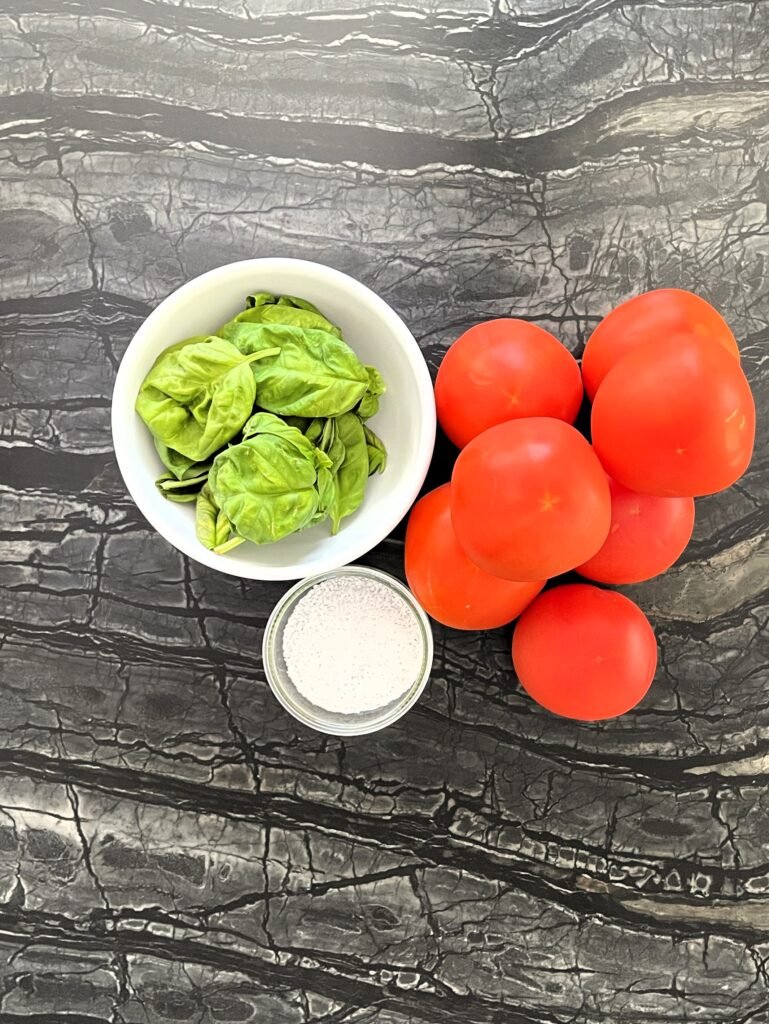
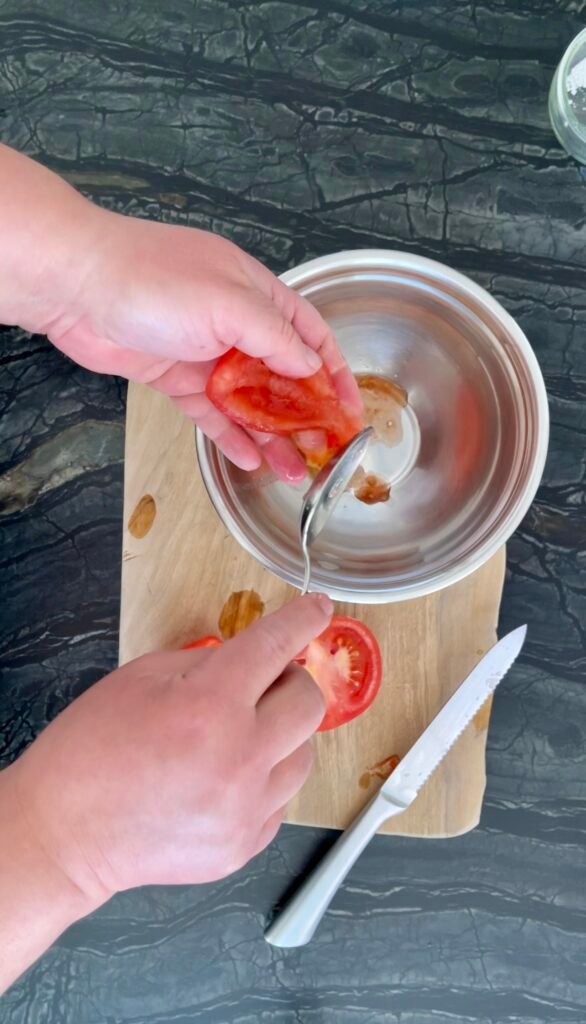
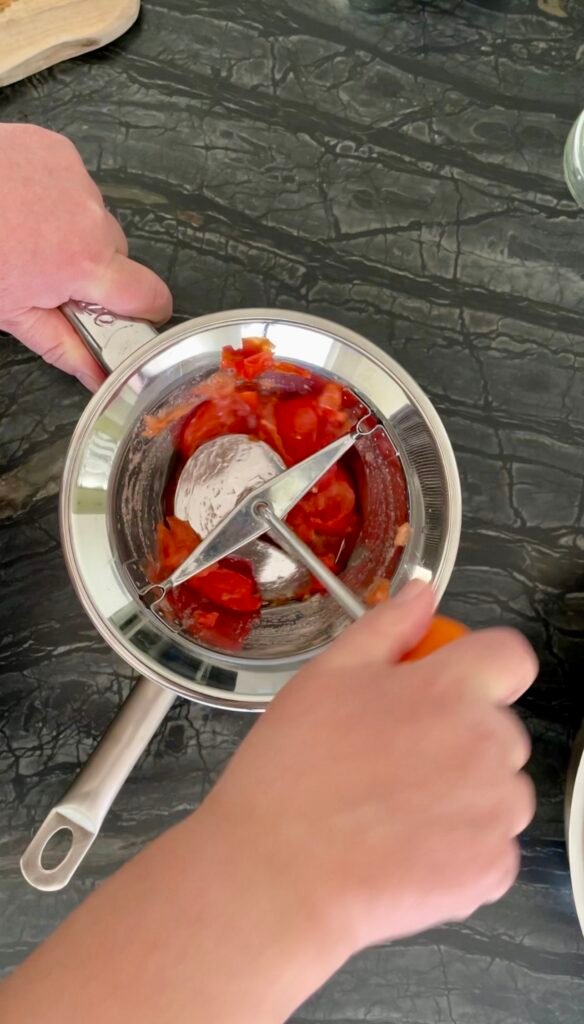

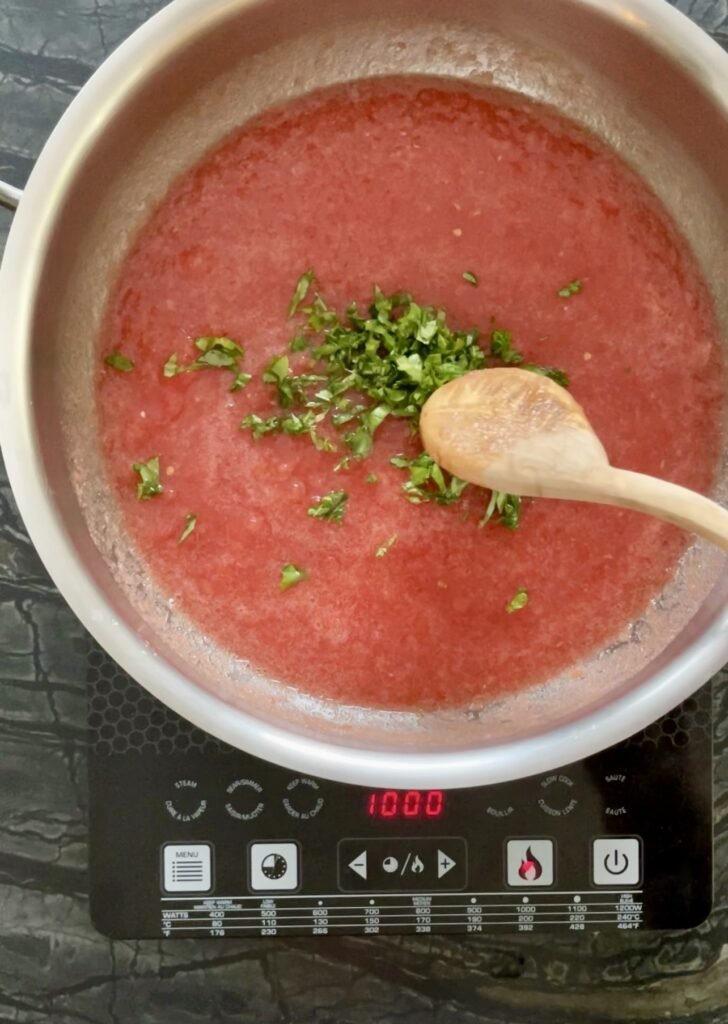
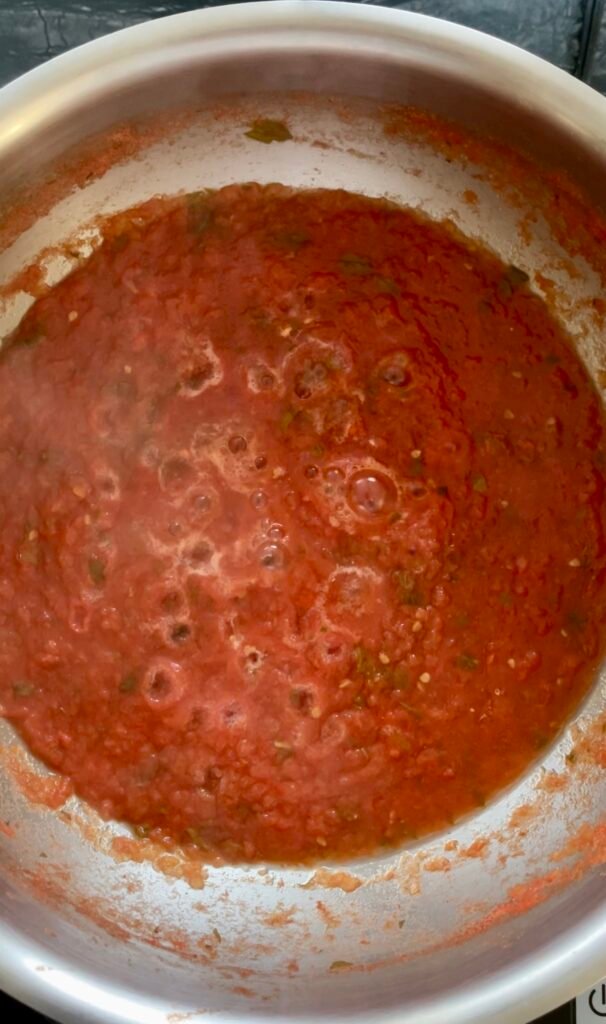
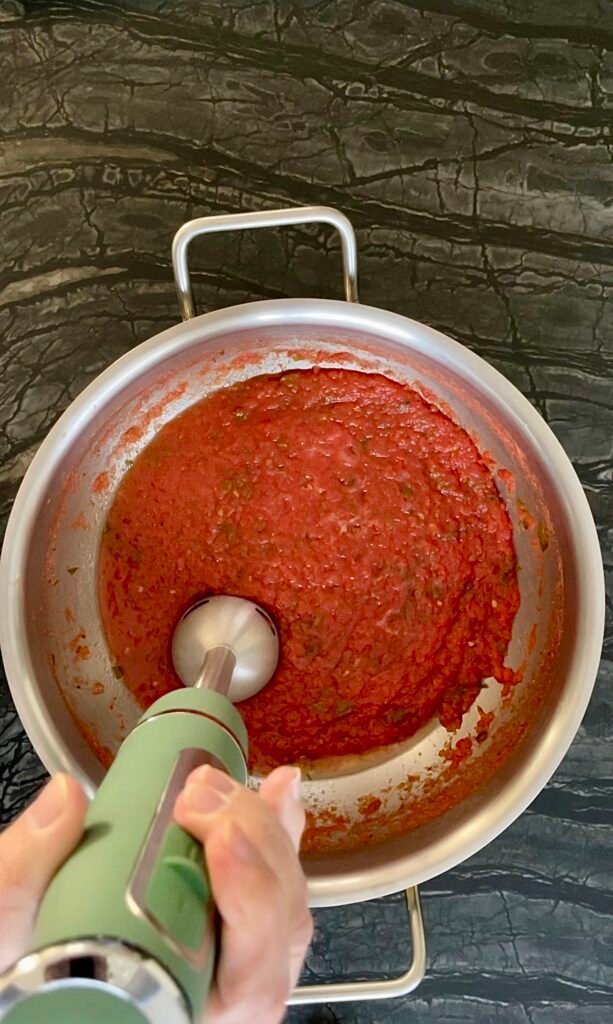
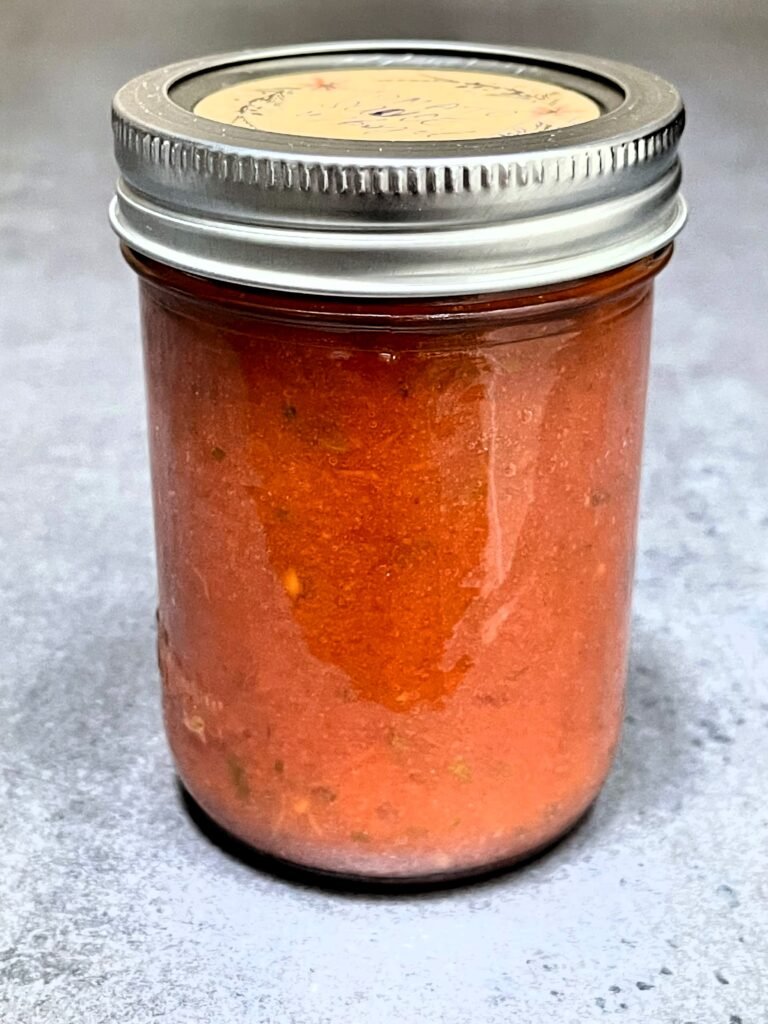
Simple Italian Tomato Sauce for Canning (No Acid)
Ingredients
- 11 lb. fresh tomatoes 5 kg. (Roma preferred, but any will do. You may have to adjust cooking time)
- 1 ½ tbsp. salt
- ½ cup fresh basil leaves loosely packed
Instructions
- Wash the tomatoes thoroughly under running water.
- Slice them in half or quarters and remove seeds and excess juice using a spoon or your hands.
- Grate de-seeded tomato (use food mill or box grater) to remove skins.
- Transfer the tomato purée to a large stockpot.
- Chiffonade the basil and add to a pot together will the salt.
- Bring to a boil over medium-high heat. Once boiling, reduce the heat but make sure that the mixture continues boiling. After 10 minutes reduce the heat to a gentle simmer.
- Cook uncovered for 40 minutes, stirring occasionally to prevent scorching. The sauce should reduce in volume and thicken to a pourable but rich consistency. If the tomatoes were particularly juicy, and the sauce is still watery, extend the simmering time as needed.
- If you prefer a smoother sauce texture, blend it at this point of the recipe preparation
- If freezing, make sure to use freezer safe containers with tight fitting lids.
- If you are canning this sauce, make sure you have canning jars ready by the end of the cooking period. Follow to the next step of these instructions.
- Carefully ladle your hot Italian tomato sauce into clean, sterilized canning jars.
- Process in a canner.
- Let the jars cool completely before storing them in your pantry.
Notes
We process our tomato sauce in the atmospheric steam canner.
| Style of Pack: Hot | Process Time at Elevations of: | ||
| Jar Size | 0 – 1,000 ft | 1,001 – 6,000 ft | Above 6,000 ft |
| Pints (16 oz, ~500ml) | 40 min | 45 min | 50 min |
*Note: Using a water bath or atmospheric steam canner for tomato sauce is not approved by the USDA. Be sure to read the official guidelines.
Frequently Asked Questions
How Is This Tomato Sauce Different From Canned Crushed Tomatoes?
Canned crushed tomatoes still have bits of tomato skin and seeds. They’re chunkier, more watery, and usually need more cooking before they taste like anything. If you make tomato sauce following our recipe, it’ll be less watery, more flavorful, and won’t taste like the inside of a metal can.
How Is This Different From Marinara?
Marinara is a finished sauce—meaning it’s ready to go on your spaghetti right out of the pot. It usually has garlic, onions, olive oil, herbs, and sometimes even wine. It’s meant to be eaten just as it is.
Our tomato sauce is more like a base. It’s just tomatoes, basil, and salt—no garlic, no oil, no extras. You can use it as-is, or build on it to make pizza sauce, shakshuka, tomato soup, or yes, even marinara.
Is this the same as passata?
Not quite—but they’re close cousins.
Passata is raw, uncooked tomato purée that’s been strained to remove seeds and skins. It’s super smooth and usually bottled right after milling—no simmering, no seasoning.
Our tomato sauce from fresh tomatoes is cooked. We use the same smooth base as passata but then we simmer it down with salt and fresh basil.
Can I make this sauce with canned tomatoes?
In theory, yes—you could use canned tomatoes. But that kind of misses the point. This recipe is all about making tomato sauce from fresh tomatoes, for canning. If you start with canned tomatoes, you’re basically working backwards.
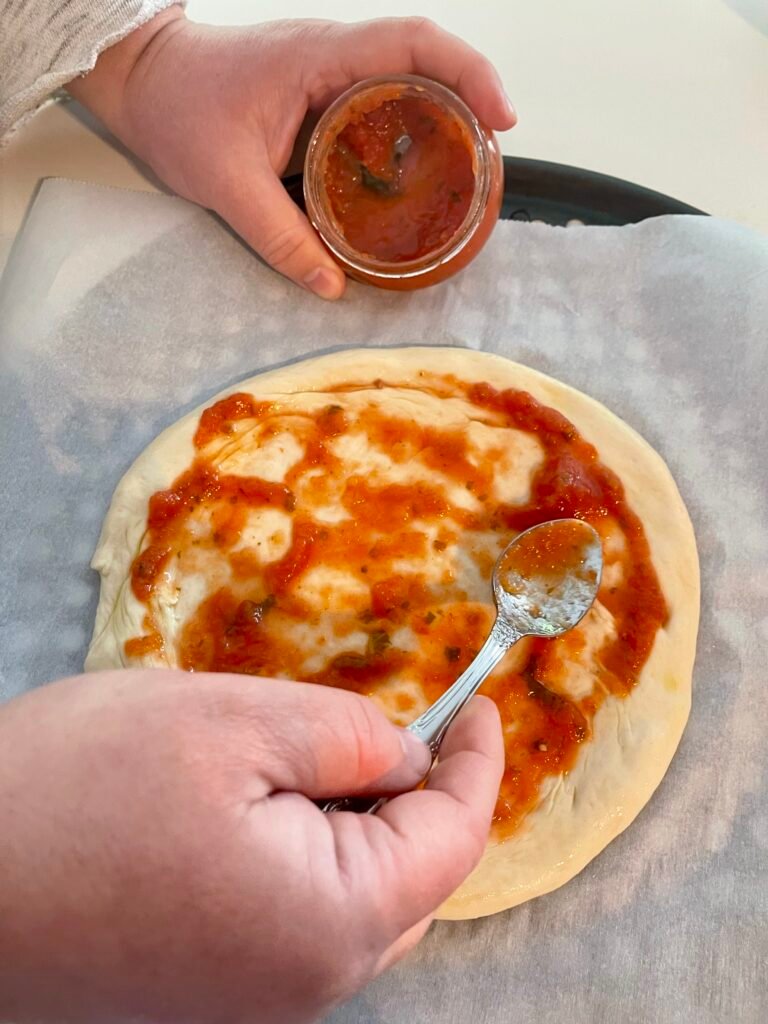

How to Use This Tomato Sauce?
- Simmer with garlic and olive oil for an instant pasta night
- Use as a pizza sauce, lasagna layer, or soup starter
- Add wine, chili flakes and even sausage and cook briefly

We can’t wait to learn how this preserve recipe worked out for you. Leave us a comment below, like us on X, Facebook, Pinterest, Instagram and Blue Sky. And remember, sharing is caring!
You May also like:
-
Simple Italian Tomato Sauce (That Any Nonna will Approve)
There’s something wildly satisfying about making a sauce that would make your real or imaginary Nonna proud – or at least make her pause before criticizing your stirring technique. This sauce isn’t fancy. It’s not complicated. No shortcuts or mystery ingredients. This is real food. Just tomatoes, salt, basil, and… read more
-
Modern Ukrainian Borscht: A Healthier Take On the Classic Dish
This borscht is a gift to your future self. It’s easy to make, feeds you for days, and freezes well for when you need it most. Whether you grew up with it or just discovered it, Ukrainian Borscht is a comfort food with staying power, perfect if you like to… read more
-
How To Make And Preserve Vegan Roasted Tomato Soup
Still reaching for that can of tomato soup? It’s about time you upgraded to something fresh and delicious! Our roasted tomato soup is packed with fennel, garlic, onion and two other mystery ingredients. It is creamy, vegan, freezer-friendly, and suitable for canning! So, next time you’re craving tomato soup, grab… read more
-
Soy Sauce Pickled Cherry Tomatoes: Try Bold, New Pickle Flavor
Yes, you can make soy sauce pickled cherry tomatoes! They are a bold twist on traditional pickles, delivering an unexpected burst of umami and sweetness. Forget ordinary vinegar-based brines—this recipe transforms your tomatoes into an unforgettable flavor bomb. Perfect for snacking or charcuterie boards, this unique pickle will wow your… read more
-
Surprisingly Simple Solution For Your Unripe Tomatoes: Green Tomato Chutney
Got a garden full of unripe tomatoes and no idea what to do with them? We have a surprisingly simple solution for your unwanted harvest. Our Green Tomato Chutney canning recipe will help you turn those stubborn tomatoes into a tangy, sweet, and savory spread you’ll love. read more
-
How To Pickle Cherry Tomatoes: Easy Recipe, Tips, And Troubleshooting
Cherry tomatoes are the candy of the vegetable world, but they don’t last forever—unless you pickle them! Try this easy, beginner-friendly recipe for the perfect homemade holiday gift. Pickled and canned cherry tomatoes make a great addition to your charcuterie board and add a pop of color, like little jewels,… read more
-
What Is And How To Make Georgian Adjika Sauce a.k.a Hot Spicy Dip?
Adjika is spicy, garlicky, deeply aromatic, and savory. But is it a sauce, a dip, a relish, or a pesto? Whatever you call it, adjika—the best-known vegetable condiment from Georgia (the country, not the state)—is guaranteed to become your new favorite for dipping, spreading, and scooping. Ready to up your… read more
-
Easy Hungarian Lesco: Hearty Tomato – Pepper Stew Canning Recipe
Just as ratatouille brings France to life, lecho (lecso) is Hungary in a bowl. This rich, sweet-and-sour stew of tomatoes and peppers uses simple ingredients with bold, unforgettable flavors. Want to enjoy it all year? Try the canning recipe and keep a taste of Hungary’s harvest season right in your… read more
-
A Better Way To Use Green Tomatoes – Pickle Them!
Let’s be honest, fried green tomatoes aren’t that special. Without the movie, we wouldn’t even be talking about them. So, what should you do with your green tomatoes? Make pickles, of course! Go ahead—make some. Bet you can’t resist eating the whole jar in one go! read more
-
Restaurant Quality Roasted Tomato Sauce For Pasta, Pizza And More
This roasted tomato sauce is a game-changer for pizza, pasta, and meatballs. The secret? We roasted Roma tomatoes and sweet onions till they blister and collapse. Then we simmered them with sautéed garlic, fresh, crushed tomatoes, oregano and lemon juice for the best tomato sauce you ever tried. Perfect for… read more


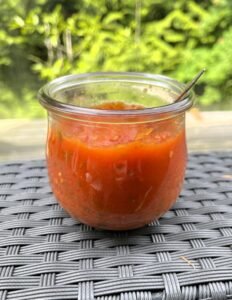
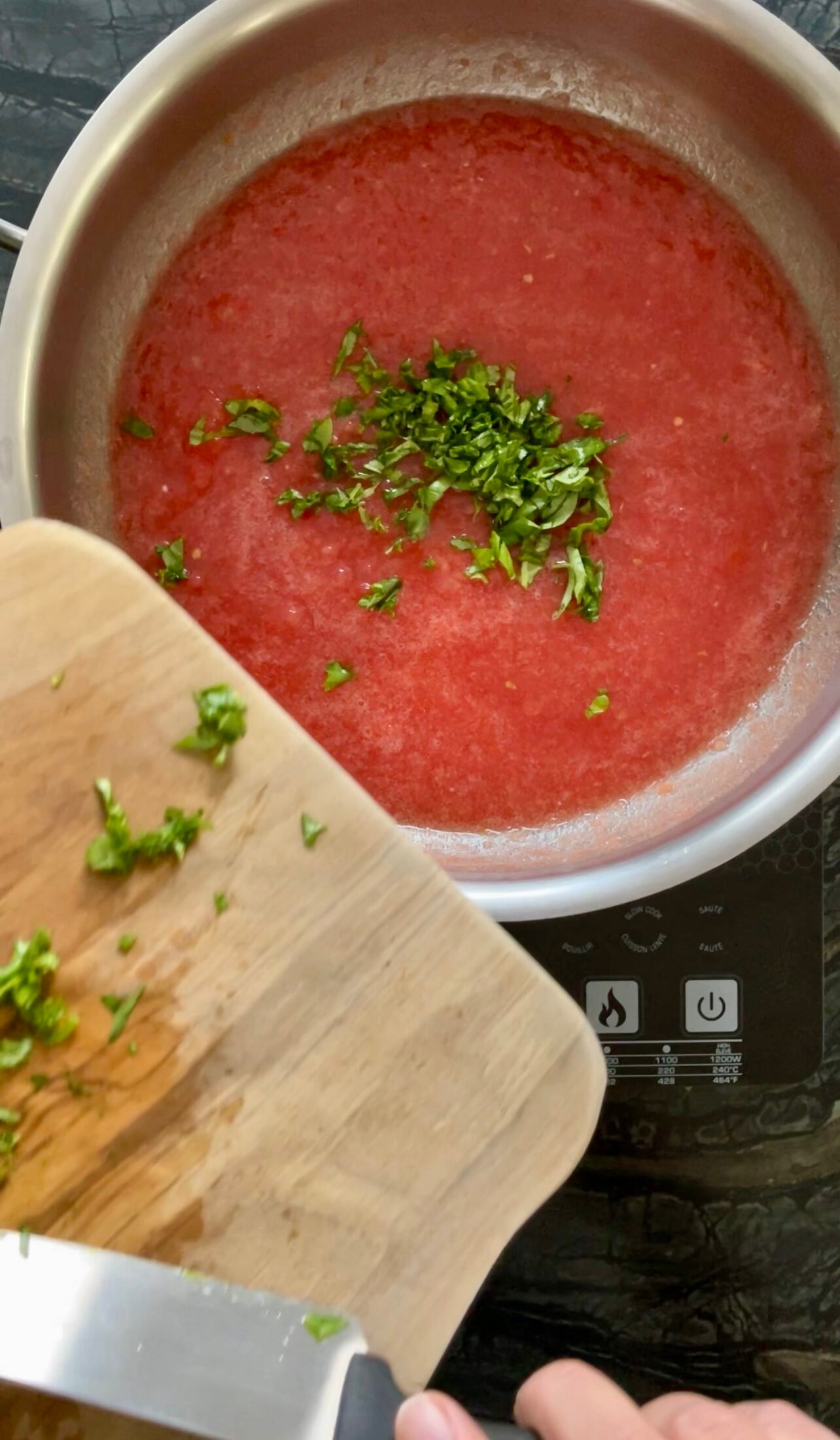
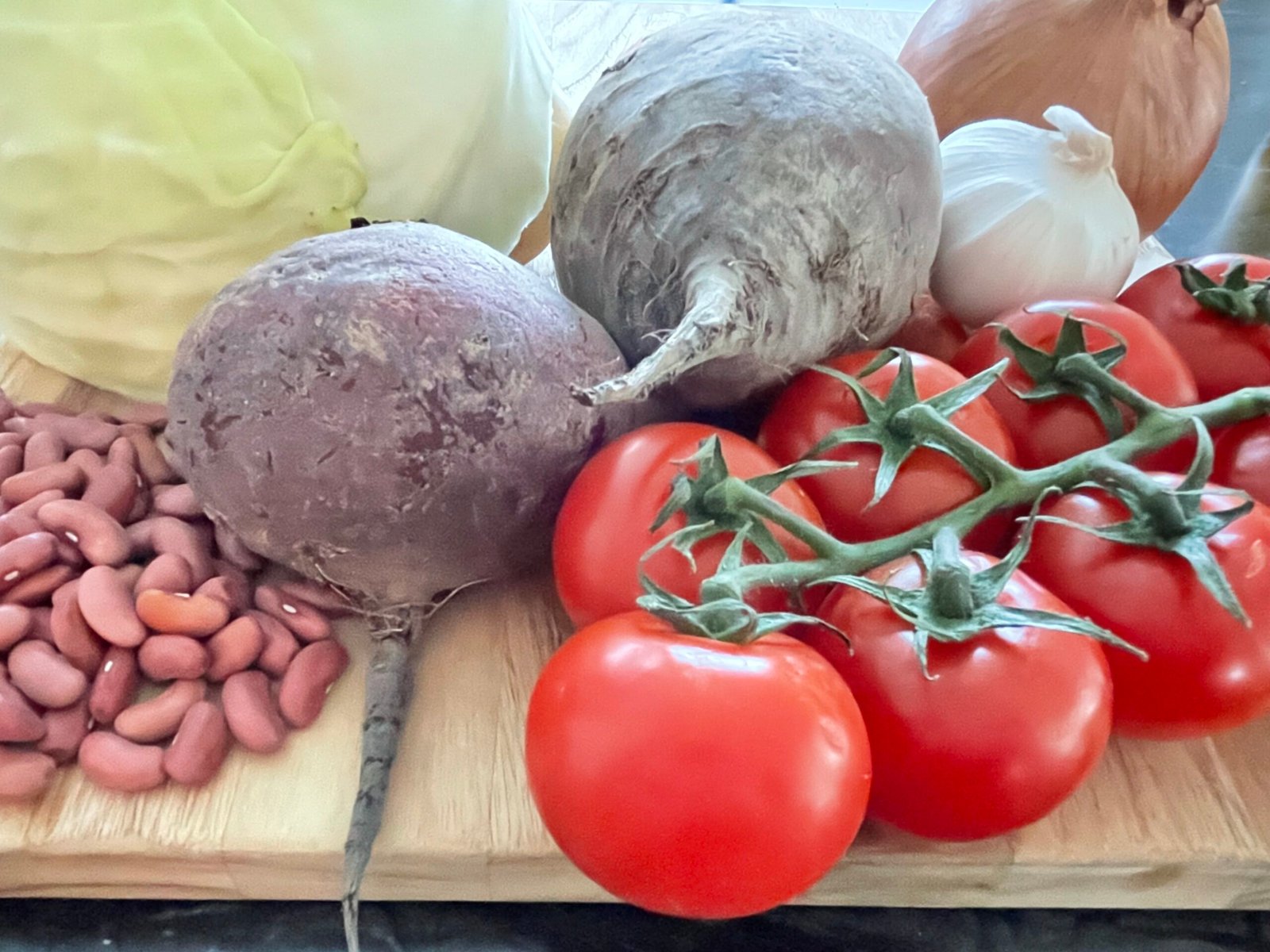
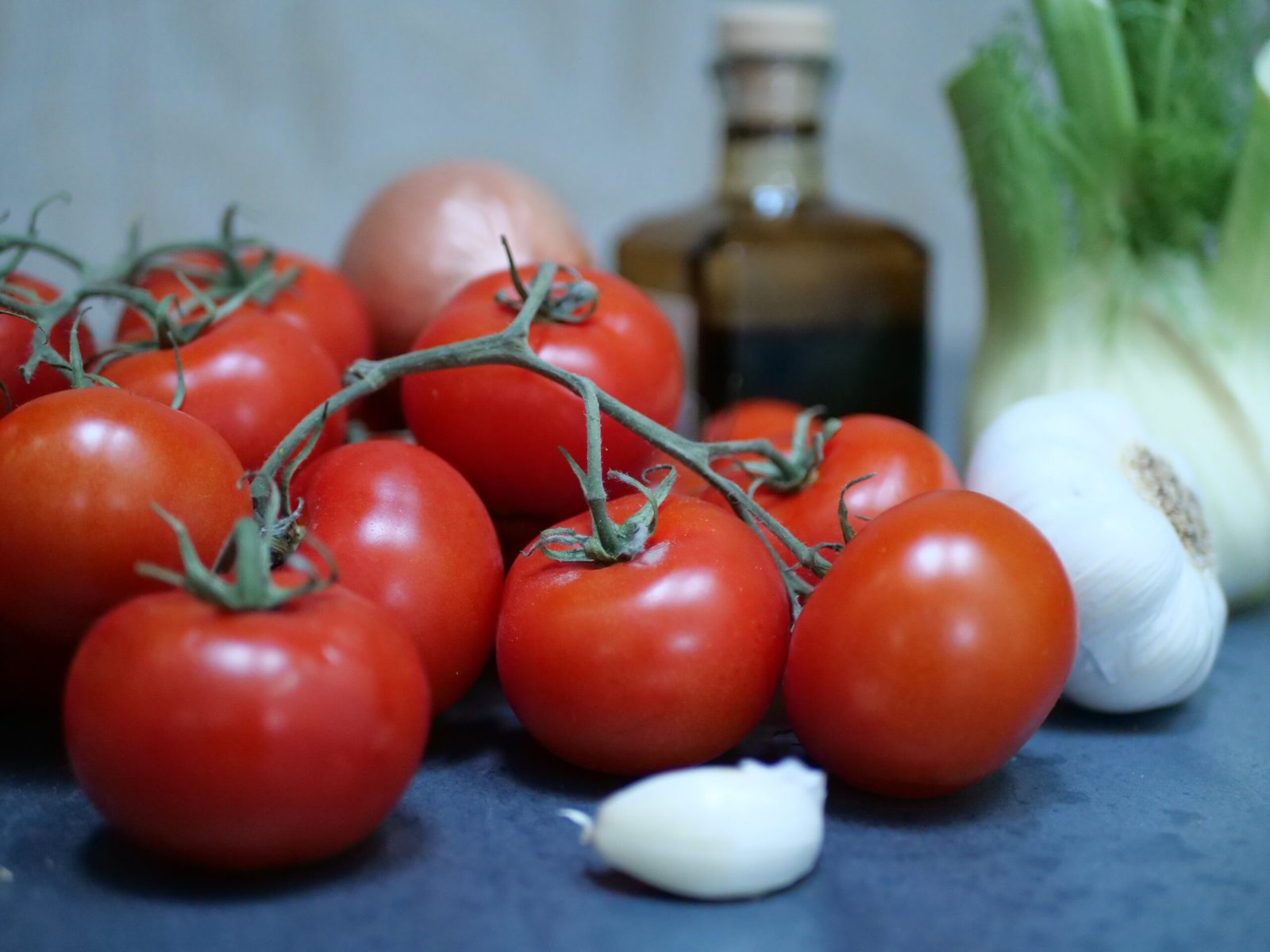
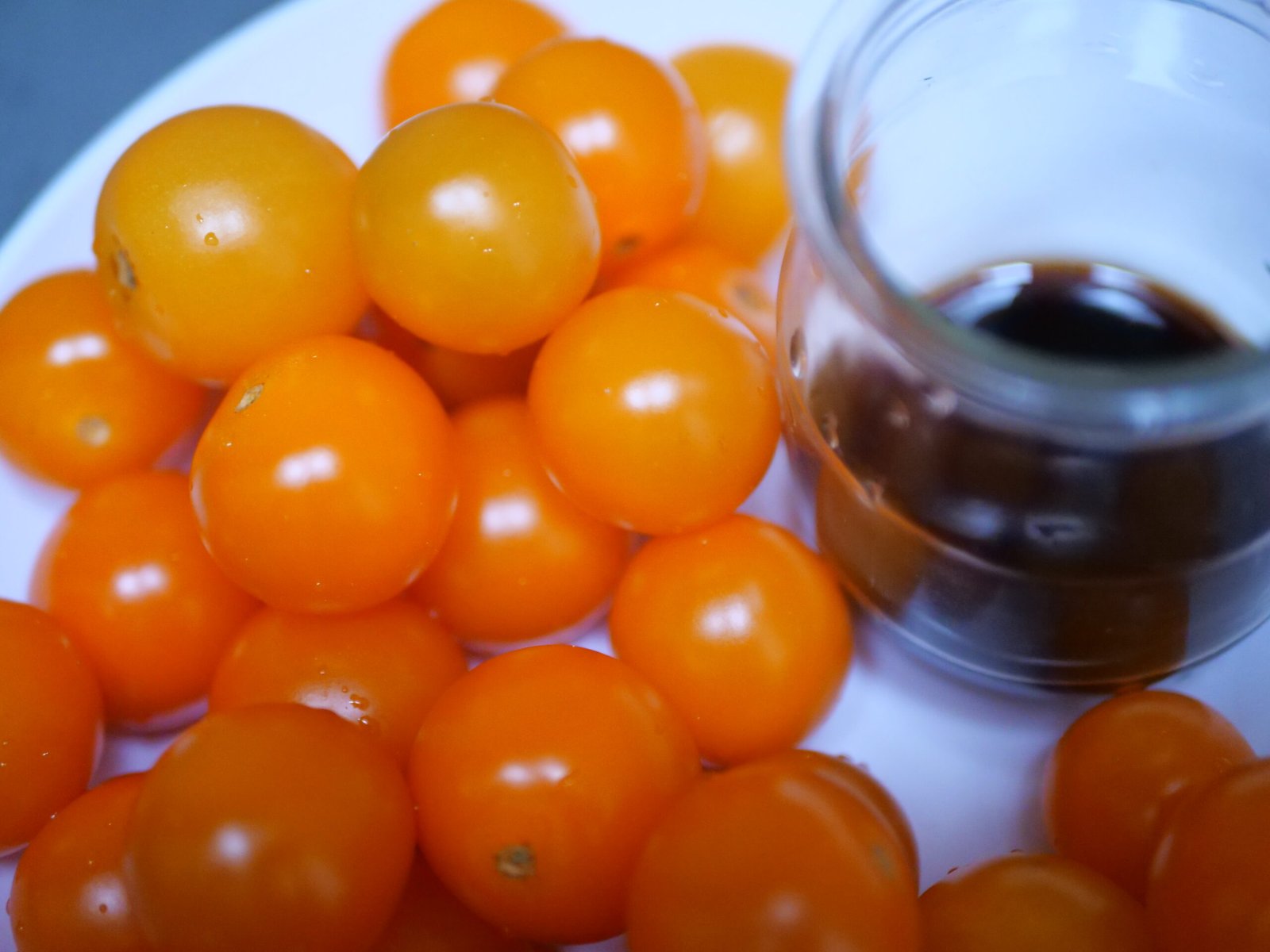
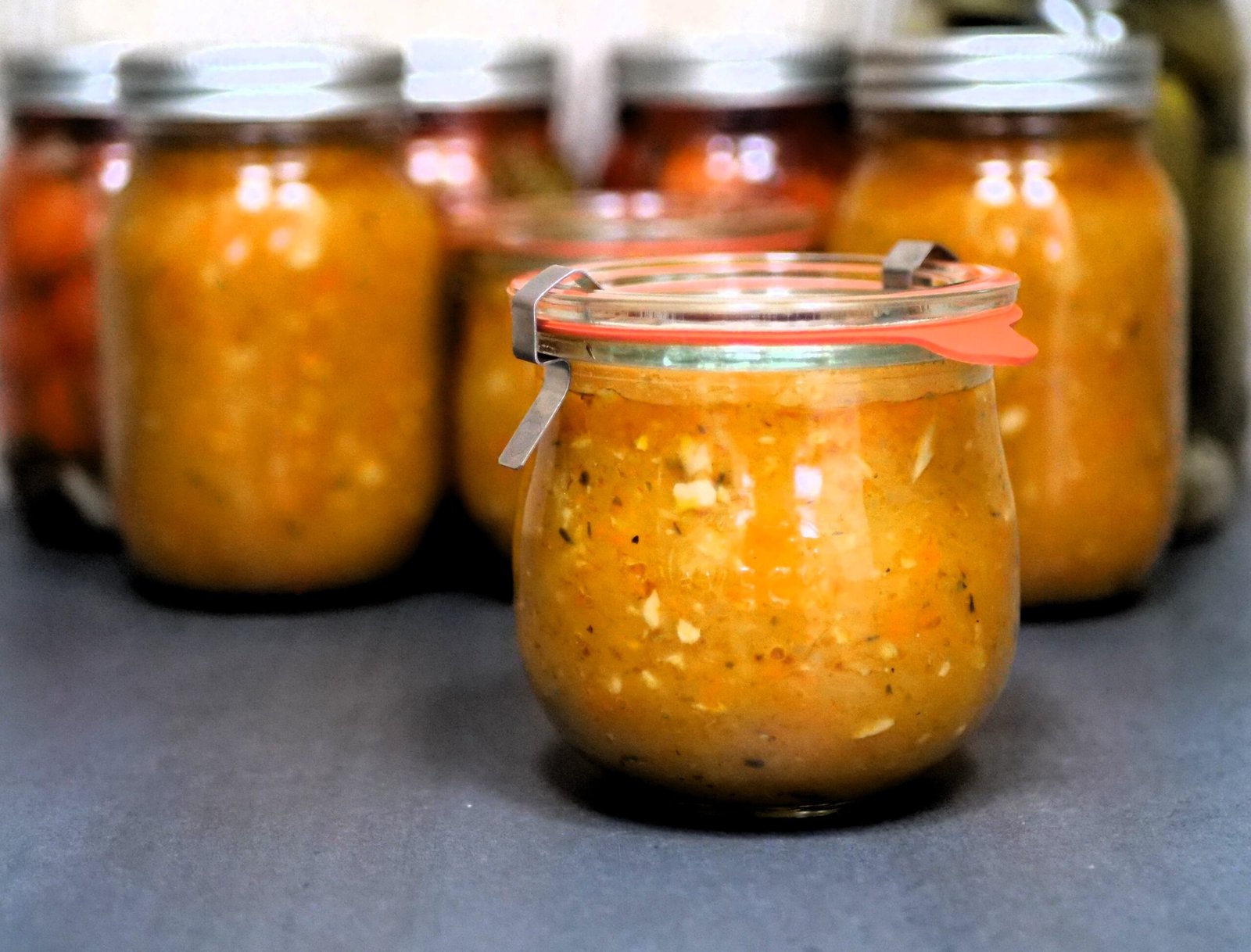
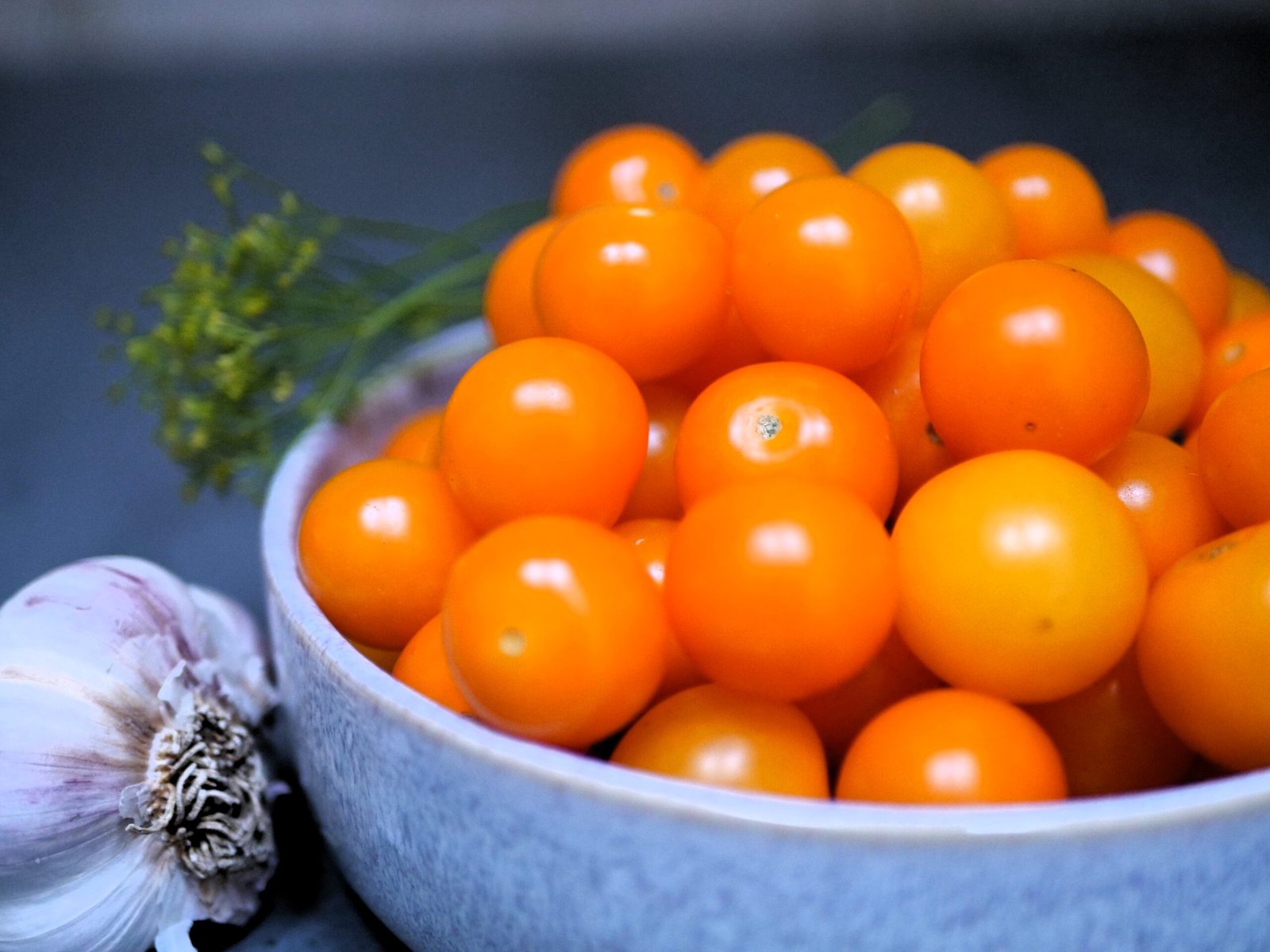

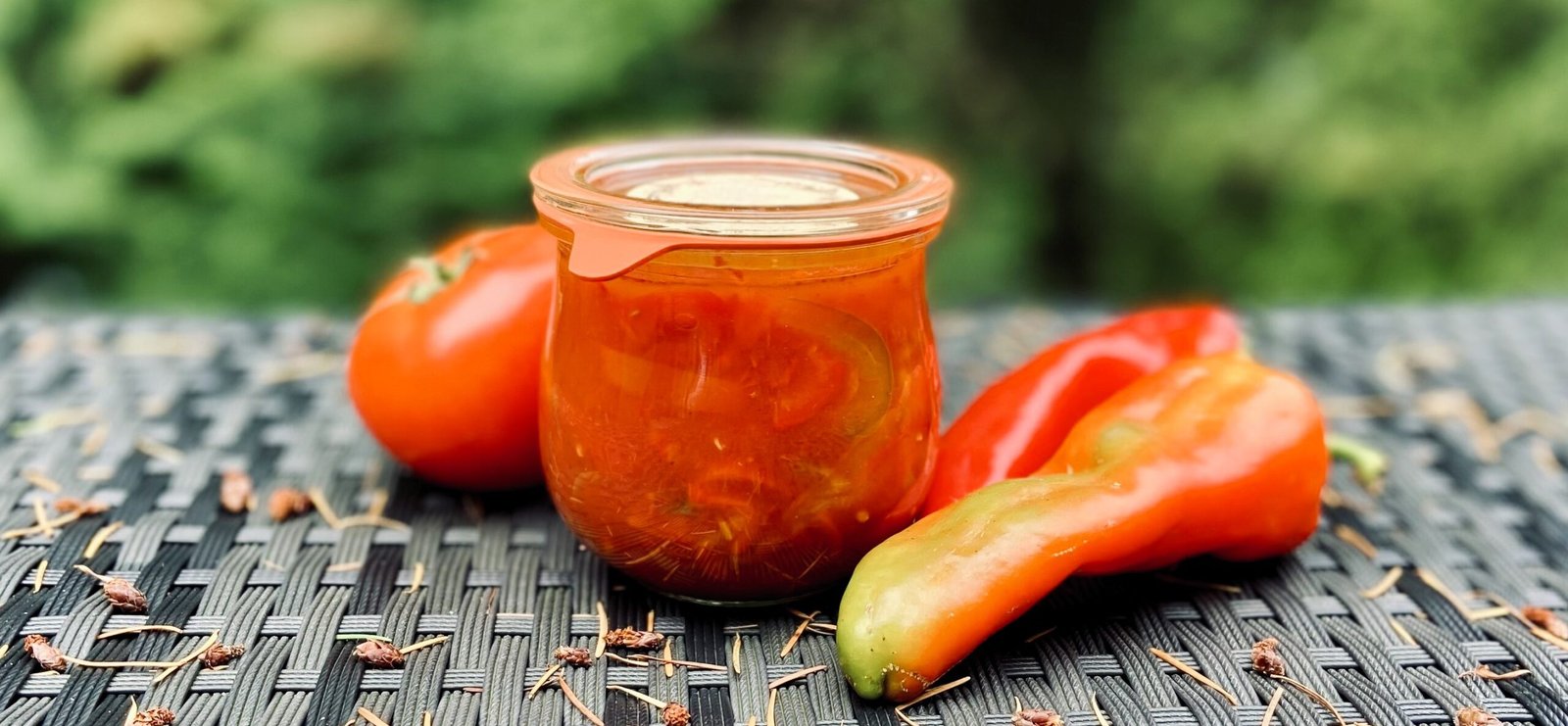




Leave a Reply